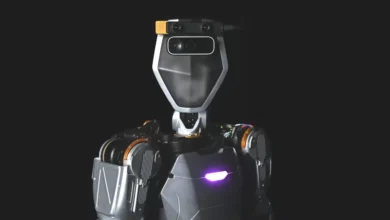Japanese scientists graft living skin onto ‘smiling’ robot

Japanese scientists have developed a technique to attach self-healing, living skin to a robot face and make it “smile”.
The scientists, led by professor Shoji Takeuchi at the University of Tokyo’s Biohybrid Systems Laboratory, connected cultured skin tissue in the likeness of a human face to an actuator – an external mechanical device – using “anchors” that mimic skin ligaments.
In a video released by the team, the scientists can be seen manipulating the skin into a smile without causing the tissue to bunch, tear or get stuck in place.
Previous efforts to attach tissue made from human cells to a solid surface would result in the skin being damaged when in motion.
While Takeuchi’s fleshy pink blob bears greater resemblance to a children’s animated character than a human face, researchers hope the breakthrough will pave the way to realistic humanoids in the future.
Buoyed by the results, Takeuchi is now looking at the bigger picture.
“Our cultured skin aims to replicate the full range of biological functions found in human skin, including the activity of facial muscles, sweat glands, sebaceous glands, pores, blood vessels, fat, and nerves,” he told Al Jazeera.
“This comprehensive functionality would enable more lifelike and interactive robotic applications.”
Biohybrid robotics advocates believe that such advances could one day herald a societal revolution where humans live alongside humanoids that look and act identical to real people.
Living skin, in particular, could allow robots to emote and better communicate with their human counterparts, ultimately blurring the boundary between homo sapiens and machines.
While visions of a humanoid-inhabited utopia – or dystopia – may seem far-fetched for now, biological robots, and their accompanying moral and ethical quandaries, are entering the world’s collective consciousness.
Takeuchi’s team at Tokyo University is only in the embryonic stages of its work, which has also included developing mini robots that walk using biological muscle tissue and 3D printed lab-grown meat, as well as research into artificial cell membranes, neural networks and implantable devices.
Takeuchi believes it will be a “long time” before robotic skin is close to 100 percent realistic, as significant advancements are needed in texture, colour and the integration of biological components.
“While we aim to create more lifelike robots, our goal is to enhance their utility and interaction capabilities,” he said.
Rafael Mestre, principal investigator at the Biohybrid Futures project based at the University of Southampton in the United Kingdom, has followed the Japanese team’s research with fascination.
“But there is still a long way to go.”
Mestre argues that tissue produced for robots will need to be carefully evaluated because research on the interaction between skin cells and robotic surfaces is still in its infancy.
“I suspect the first examples we see will be of some artificial skin acting as a coverture for a small-scale and simple biohybrid robot based on muscle tissue that can perform some basic form of actuation or movement, rather than in a humanoid robot with a real skin face,” he said.
Mestre sees numerous potential applications for such technologies if research continues to advance, such as plastic surgery, anti-ageing research and drug testing.
Other active areas of research include insect cyborgs – an area of interest for the United States government’s DARPA agency since 2006 – and biohybrid robots used for cleaning oceans or search-and-rescue operations.
Misuse and abuse
Concerns about the misuse and abuse of future technologies have also spurred calls for safeguards to be put in place.
In a recent paper published in the Proceedings of the National Academy of Sciences of the United States of America, researchers at the University of Southampton called for better regulatory frameworks and ethical guidelines for biohybrid robotics development.
The authors, who included Mestre, pinpointed three main areas of concern in the nascent field: how biorobots will interact with humans and ecosystems, the potential integration of biorobots into human bodies, and ethical considerations regarding a biorobot’s moral status.
Takeuchi acknowledges ethical concerns, saying it will be crucial to implement regulatory measures and guidelines to ensure the technology is used responsibly.
“While creating lifelike robots offers many benefits, we must carefully consider the implications and maintain transparency and control over their development and deployment,” he said.










